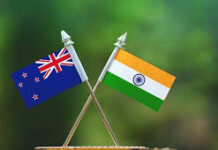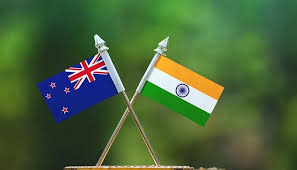India, located in South Asia, is one of the most populous countries in the world. With a diverse climate ranging from tropical in the south to temperate and alpine in the north, India offers rich cultural heritage and multiple official languages. New Zealand, situated in the southwestern Pacific Ocean, consists of two main islands with a temperate maritime climate. Known for its breathtaking natural beauty and low population density, New Zealand places high emphasis on sustainability and quality of life.
| Category | India | New Zealand |
|---|---|---|
| Geography | South Asia | Southwestern Pacific Ocean |
| Capital City | New Delhi | Wellington |
| Official Language(s) | Hindi, English | English, Māori, NZ Sign Language |
| Time Zone(s) | IST (UTC+5:30) | NZST (UTC+12), NZDT (UTC+13) |
| Climate | Tropical to temperate | Temperate maritime |
| Population | ~1.43 billion | ~4.9 million |
| Currency | Indian Rupee (INR) | New Zealand Dollar (NZD) |
India vs New Zealand Economy & Development
India is one of the fastest-growing major economies, powered by a mix of services, industry, and agriculture. Its large domestic market supports a diverse economic structure. Despite strong GDP growth, challenges like poverty and income inequality persist. New Zealand, though smaller in economic size, enjoys a high standard of living with a strong services sector, agricultural exports, and innovation-driven growth. Its low corruption and high ease-of-doing-business rankings make it attractive for investors.
| Indicator | India | New Zealand |
|---|---|---|
| GDP (Nominal) | $4.27 trillion | $262.92 billion |
| GDP per Capita (Nominal) | $2,940 | $48,231 |
| GDP per Capita (PPP) | $11,942 | $54,049 |
| GDP Growth Rate | 6.4% | 0.8% |
| Unemployment Rate | 2.6% | 3.3% |
| Inflation Rate | 3.34% | 2.2% |
| Major Industries | IT, textiles, agriculture, pharmaceuticals | Agriculture, tourism, finance, forestry |
| Cost of Living | Lower | Higher |
| Income Tax Rate | 30.9% | 33% |
| Poverty Rate | 44% below $3.65/day (2021) | 11.0% (relative, 2014) |
| HDI (Human Development Index) | 0.644 (2022) | 0.939 (2022) |
India vs New Zealand Education
India’s education sector is evolving with reforms like the National Education Policy (NEP) 2020. It has a strong presence in engineering, management, and technical education through institutions like IITs and IIMs. However, literacy levels and infrastructure in rural regions need attention. New Zealand maintains a globally competitive education system, with a focus on inclusivity, research, and global exchange. It’s a favored destination for international students.
| Indicator | India | New Zealand |
|---|---|---|
| Literacy Rate | 80.3% (2022-23) | 99% |
| Top Universities | IITs, IIMs | University of Auckland, University of Otago |
| Education Quality | Improving; NEP 2020 initiatives | High; consistent global rankings |
| Study Abroad Options | Increasing | Popular destination for international students |
India Vs New Zealand Technology & Infrastructure
India is rapidly digitizing with growing internet access, widespread mobile usage, and major investments in smart cities and transportation. However, rural infrastructure and consistent power supply remain areas for improvement. New Zealand has a well-integrated and modern infrastructure system, with excellent public transport, reliable utilities, and high internet penetration, contributing to efficient urban and rural development.
| Indicator | India | New Zealand |
|---|---|---|
| Internet Penetration | Growing rapidly | High |
| Mobile Coverage | Extensive | Comprehensive |
| Transport System Quality | Developing; major urban centers have metro systems | Advanced; well-maintained public transport |
| Power Supply Reliability | Improving; challenges in rural areas | High |
| Urban vs Rural Development | Significant disparity | Balanced |
India Vs New Zealand Environment
India faces pressing environmental challenges, including air and water pollution, deforestation, and rapid urbanization. Efforts are ongoing to boost renewable energy and implement sustainable policies. New Zealand is renowned for its eco-conscious policies and clean environment. It prioritizes conservation, biodiversity, and climate change initiatives, making it one of the most sustainable nations globally.
| Indicator | India | New Zealand |
|---|---|---|
| Air Quality | Often poor in cities | Excellent |
| Renewable Energy Usage | Increasing focus; ~23% of energy mix | High usage; ~40% of total energy |
| Environmental Policy | Developing and inconsistent | Strong and proactive |
| Carbon Emissions per Capita | 1.9 tons | 7.8 tons |
| Biodiversity Protection | In progress | Well-protected |
| Climate Change Actions | Emerging | Leading |
India Vs New Zealand Conclusion
India and New Zealand present two distinctly different yet equally compelling national profiles. India, with its vast population and rapidly evolving economy, is a powerhouse of cultural diversity, innovation, and potential. It is progressing steadily in technology, infrastructure, and education, despite facing challenges in health, environment, and equitable development. New Zealand, on the other hand, offers a high standard of living with robust governance, strong environmental policies, and a focus on sustainability and social well-being.
While India excels in scale and growth opportunities, New Zealand stands out for quality of life and systemic efficiency. The comparison highlights how each nation addresses its unique challenges and leverages its strengths to shape its future. Whether you’re an investor, student, traveler, or global citizen, the choice between the two depends largely on your priorities—be it dynamic growth or tranquil quality.






